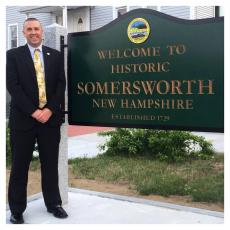Brief History of Somersworth
In 1729, a small village along the Salmon Falls River (named the Newichwannock by the local native Americans) separated from Dover to form the parish of Summersworth. The villagers found the travel to attend the church in Dover to worship on Sunday difficult to impossible in the winter. So, when the population reached a number large enough to support a minister, taxes were collected and a Meetinghouse was erected. The name derives from the Anglo-Saxon word ‘sumer meaning summer and ‘worth an ending used in place names meaning manor or town.
The town was formally incorporated in 1754, and the spelling changed when the man who copied out the charter wrote ‘Somersworth’. In 1849, for a variety of economic and political reasons, the area of Somersworth known as Salmon Falls Village incorporated as separate town called Rollinsford. The Great Falls Village area of the town retained the name Somersworth.
Gershom Horne’s gristmill, waterpower and land by the Great Falls, with its one hundred foot drop, sold for five thousand dollars and became the site of the No. 1 factory of the Great Falls Manufacturing Company.
Isaac Wendall, a Quaker, repeated the success he had organizing the manufacture of cotton cloth in Dover at the Cocheco Falls, and incorporated the company on June 11, 1823. At its peak, the Great Falls would power turbines to turn in Mill #1, pictured below, 1,500 spindles to make 7,000 yards of cloth. The company would eventually have 7 textile mills along the riverbank below the Great Falls.
The Bleachery became the longest running textile operation in Somersworth. The building housed the operations that took the buff colored fabric produced in the seven mills and transformed it into a sparkling white material that could be dyed or printed according to the buyer’s wishes. The Bleachery continued to operate well into the 1990’s, before closing in 1997. Recently, vandals set a fire that destroyed about 30% of the building during the middle of a renovation.
Other industries flourished including the Somersworth Machine Company, who’s ‘White Mountain Stove’ was renowned for its efficiency, the Great Falls Woolen Company on Buffumsville Road, and the Consolidated Light and Power Company. The shoe industry joined the textile industry in Somersworth with a new factory built in the 1880s on the corner of Indigo Hill and Main Street. The top floors of this building were burnt in the 1980’s and it now houses a laundromat and electrical supply store.
This grand schoolhouse arose on Prospect Hill in 1849. The building was 71 feet long and 51 feet wide, two stories high on a lot of approximately two acres, surrounded by streets. One entrance was for girls and one for boys with anterooms at each for hanging up clocks and caps. The first floor was divided into two rooms, one for the primary grades and one for intermediate grades. The second floor was dedicated solely for a high school, with one large room and two small ‘recitation’ rooms. Three hundred and forty students could attend this large modern facility. It is often said that Somersworth had the first high school in the state. However, the Third Annual Report of the Commissioner of Common Schools to the Legislature of New Hampshire, June session, 1849, which contains a detailed account of the construction of this school, also reports on the activities of high schools in Manchester and Portsmouth. It is more likely that this was the first building constructed in New Hampshire to be used for the express purpose of a public high school.
This view of Main Street, between Market and Station Streets, was taken sometime in the late 1880’s, and features buildings lost in a fire in 1939. John Greenleaf Whittier’s brother ran the hotel, built by the owners of the Great Falls Manufacturing Company. The noted New England poet was a frequent visitor. Located across from the hotel was the Boston & Maine Union Station built in1886-87. This building was constructed on the site of two earlier train stations when the Boston & Maine Railroad took over the Eastern Branch of the Eastern Railroad.
On the north end was the baggage room and the south end was the waiting room, offices and a restaurant. Beside the tracks was a covered wooden platform to protect passengers as they boarded the trains. The station outlasted the hotel but closed in 1953 when passenger service ended, but fittingly has been a restaurant for a number of years.
The first building on this land on the corner of High and Highland Street was a three-story Federal style double house, owned by Hiram Hanson, a grocer. The Littlefield Post of the Grand Army of the Republic razed this house when they purchased the land. The building was erected in 1889 in memory of the Union soldiers of the Civil War. It served veterans and sons of veterans as a meeting place for many years. As the GAR declined, the third floor was leased to Libanus Lodge, Free and Accepted Masons for a number of years. The Woman’s Club of Somersworth met in this building from their founding in 1895 to 1915. The building currently is home to a number of offices.
All the businesses, homes and churches on Market Street and on Main and High Streets in the downtown area are built on land originally owned by Gershom Horne for his farm and then owned by the Great Falls Manufacturing Company. The Company owners sold off the land holdings away from the river and canal within a decade; they donated land for the Congregationalists, Methodists and Baptists churches to be built with the stipulation the land be used solely for religious purposes. Brick tenements were built to house workers, and residents benefited from graded streets, a reservoir on Prospect Hill, and a fire department. The picture above is High Street looking west at what was known as Lincoln Square. At the left is the Somersworth Savings Bank by local architect Fred N. Footman and built on this site in 1876. It had three stories of shops and offices under its Mansard roof. It was destroyed by fire in the 1963 and a modern band building opened in 1965. Several banks occupied this building before it was purchased by the city in 2001 and renovated into the current City Hall on the corner of High and Station streets. Note both the trolley car and tracks in the center of High Street and the horse-drawn cart traveling on the right.
Further information about the history of the City of Somersworth is available at the Somersworth Public Library and the Summersworth Historical Society and Museum at 157 Main Street, open on Sunday from 12:30PM-3:30PM.
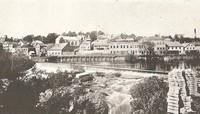
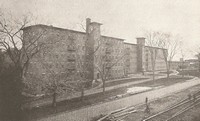

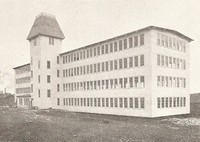
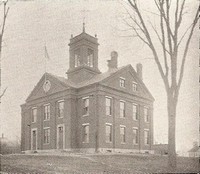
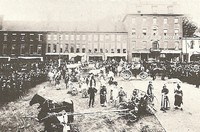
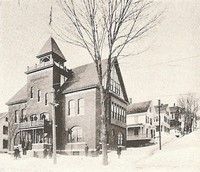
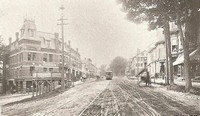
Left to right first row: Downtown Somersworth with the Great Falls on the Salmon Falls River in the foreground; Great Falls Manufacturing Company Mill No.1; The Bleachery, Second row: The New Shoe Factory; the first Somersworth High School on the hill in 1850; The Great Falls Hotel on the 4th of July, Third row: The Grand Army of the Republic Building in the corner of High and Grove Streets; Lincoln Square at the corner of High and Fore (now Station) Streets

